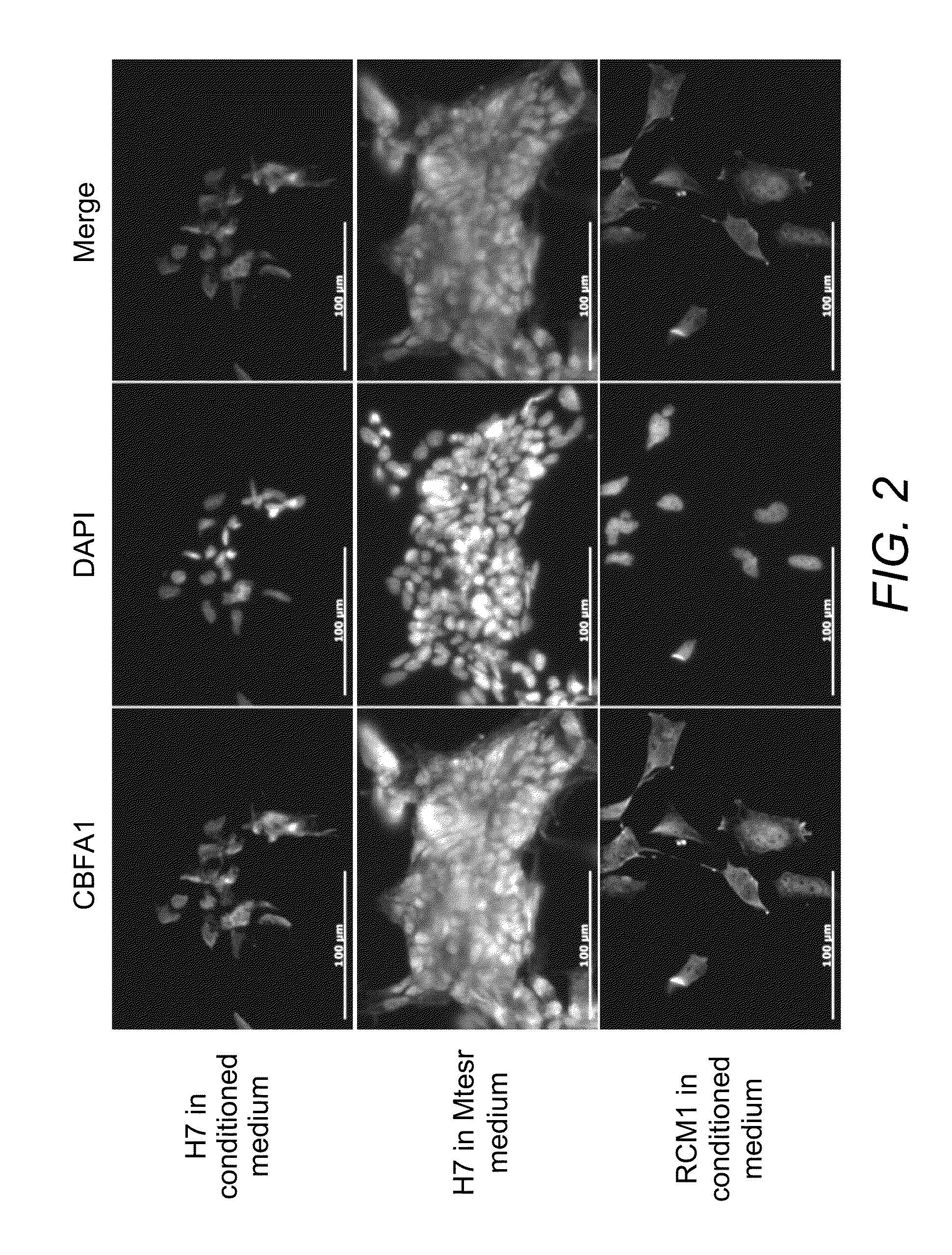Chondrogenic progenitor cells, protocol for derivation of cells and uses thereof
a progenitor cell and chondrocyte technology, applied in the field of cell biology, embryonic stem cells, cell differentiation, can solve the problems of complex development of new transplantation protocols, insufficient treatment of most cases of cartilage degeneration, joint pain and mobility impairment to a degree, etc., and achieve the effect of modulating chondrocyte growth and differentiation
- Summary
- Abstract
- Description
- Claims
- Application Information
AI Technical Summary
Benefits of technology
Problems solved by technology
Method used
Image
Examples
example 1
Production of Chondrocyte Progenitor Cells
[0199]The DCCPCs were produced using a protocol as follows. Initially H7 ES cells were grown to 80% confluency using Matrigel® coated flasks and standard ES culture conditions. At this point the media was replaced with chondrogenic media. The cells remained in their original flasks and still on Matrigel® thus reducing cost and handling. Cells were cultured in these conditions for a further 14 days with chondrogenic media replaced 3 times a week. On day 14 the cell layer was washed with PBS and the chondrogenic media replaced with dedifferentiation medium. Again the cells remained in their original flasks. After a further 5 days in culture the cells showed signs of dedifferentiation and were trypsin passaged as single cells.
Materials
[0200]The materials used were: conditioned media, bFGF (Peprotech), tissue culture flasks (Nunc), Matrigel® (BD Biosciences), DMEM (Sigma), and FBS (Gibco).
Protocol
[0201]hESCs were cultured to confluency on Matrig...
example 2
Morphology
[0207]The morphology of the cells changes dramatically throughout the protocol. After 14 days in our chondrogenic medium the cells show classic chondrocyte morphology with rounding up of the cell body and clustering of cells into dense colonies (FIG. 1). On day 14 the media is changed to dedifferentiation media and at days 15 through 19 in dedifferentiation media, the cells show a fibroblast like morphology and start to repopulate the culture surface
[0208]A high proportion of the original ES cells died and formed rafts of dead cells that appeared as phase bright clumps just above the cell layer. These clumps could be washed off but not without substantial agitation. After 14 days the confluency was as low as 20%. However, the increase in colony density suggested that this decrease in confluency is not directly related to a decrease in cell number.
[0209]After replacement of the chondrogenic medium with de-differentiation media, cell morphology changed dramatically. Cells mi...
example 3
Characterisation of the DCCPCs
[0211]The de-differentiated cells were trypsin passaged and detached from the Matrigel® (and also plastic in later time points) in <5 minutes, as single cells. At this point the suspension of cells was used either for construct formation or the plastic adherent cells seeded for characterisation.
Plastic Adherent Cells:
[0212]Plastic adherent DCCPCs maintained in de-differentiation media analysed using FLOW cytometry showed no ES pluripotency markers or MSC markers.
[0213]In agreement with the FLOW data, immunocytochemistry using a different Tra-1-60 antibody showed no evidence of TRA-1-60 protein expression in the DCCPCs. Tra-1-60 staining was not present on the plastic adherent DCCPCs. Undifferentiated H7 ES cells were used as a control for the antibody and showed bright membrane associated staining. After counting 1053 cells no TRA-1-60 positive cells were seen in the DCCPC population. Therefore TRA-1-60 protein expression is undetectable in this populat...
PUM
| Property | Measurement | Unit |
|---|---|---|
| surface area | aaaaa | aaaaa |
| time | aaaaa | aaaaa |
| concentration | aaaaa | aaaaa |
Abstract
Description
Claims
Application Information
 Login to View More
Login to View More - R&D
- Intellectual Property
- Life Sciences
- Materials
- Tech Scout
- Unparalleled Data Quality
- Higher Quality Content
- 60% Fewer Hallucinations
Browse by: Latest US Patents, China's latest patents, Technical Efficacy Thesaurus, Application Domain, Technology Topic, Popular Technical Reports.
© 2025 PatSnap. All rights reserved.Legal|Privacy policy|Modern Slavery Act Transparency Statement|Sitemap|About US| Contact US: help@patsnap.com



